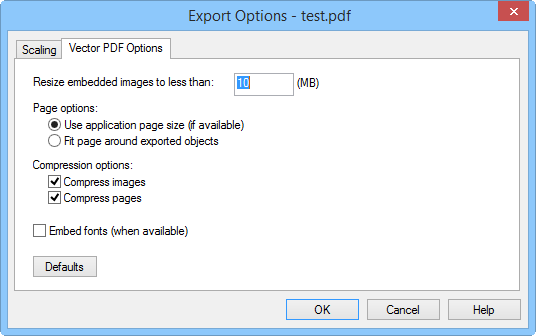
Set image compression and page size options
Adobe Acrobat Portable Document Format .PDF is a file format used for document exchange. PDF is used for representing two-dimensional documents. PDF was created by Adobe Systems. The vector .PDF export supports solid pattern, image, and gradient patterns.
Use a vector .PDF to export the vector objects in the project (lines and text) as vector objects in the PDF. This makes the objects clear and sharp. Vector objects do not lose quality when you zoom in. It doesn't matter how much you zoom in, the line and text will always look crisp.
The images in your project will also export as images in the vector .PDF. Vector .PDF files are smaller than Raster .PDF files and are usually higher quality. The drawback is that some fill patterns are not supported, so the output may not look exactly the same as your original project.
Objects that are transparent or partially transparent in MapViewer are exported with the transparency enabled in the .PDF, with a few exceptions. If the object is filled with an image fill pattern, the object is always exported as 100% opaque, regardless of the opacity setting. If the object is filled with a stock fill pattern, the object's Foreground Opacity and Background Opacity are averaged and the object is exported with a single average opacity.
See Scaling
When using the File | Export command to export to a PDF (Vector) file, the Export Options dialog allows you to specify the Scaling options and Spatial Reference options to create a GeoPDF file. To create a GeoPDF, check the Internal File Format option on the Spatial References tab.
Only a single map object can be exported to a GeoPDF. If multiple map objects exist in the MapViewer file, all maps should be overlaid before exporting. If other drawn objects (legends, scale bars, text, etc.) exist in the MapViewer file, these objects should be temporarily deleted before exporting.
An add-on, such as TerraGo toolbar, may be needed to view the GeoPDF options in Adobe's Acrobat or PDF Reader programs. The map layer and map must have an assigned coordinate system in MapViewer prior to the export.
In addition, the Vector PDF Options page is available to resize and compress image and to include the page size in the .PDF file.

Set image compression and page size options
on the Vector PDF Options page in the Export Options dialog.
The Resize embedded images to less than option specifies the size in megabytes that an embedded image is resized to during export. Enter a value in the MB box. If an exported image exceeds this size, its resolution will be reduced so it doesn’t exceed the designated maximum size. Increase this value to get better looking images at the expense of larger export files. The default value of Resize embedded images to less than option is 10MB.
As long as there is no shear, perspective, or clipping, PDF text entities will be exported as text. This means that the PDF text entities will be sized and oriented similar to the text objects in the application document. When shear, perspective, or clipping occur, the text is exported as solid polygons. Shear occurs when the character glyphs are not perpendicular to the text baseline. Perspective occurs when the height of glyphs in the text string are not all the same, as in a 3-D view where the glyphs are smaller the farther they are from the observer. Clipping occurs when part of the text object is partially inside and partially outside the map limits.
The Page Options section controls the page size in the exported .PDF file. Select the Use application page size (if available) to use the paper size defined in the Page Setup dialog. If Fit page around exported objects is selected, the page size in the .PDF file will be only as large as the objects being exported.
When the Use application page size (if available) is selected and objects extend beyond the page defined in the Page Setup dialog, the objects are clipped and not displayed in the PDF file.
Check the box next to Compress images to apply .PDF compression to the images in the .PDF file. This produces smaller vector .PDF files with no loss in quality. When this option is unchecked, .PDF files will be larger.
Check the box next to Compress pages to apply .PDF compression to the entire page stream. This produces significantly smaller vector .PDF files with no loss in quality. When this option is unchecked, .PDF files will be larger.
Check the box next to Embed fonts (when available) to store the fonts inside the .PDF file. This produces a larger vector .PDF file, but the font in the .PDF file will exactly match the font in the MapViewer file. When this option is unchecked, the .PDF file will be smaller, but the text may not appear the same in the .PDF file as it does in the MapViewer file. Some fonts cannot be embedded. A different font is substituted when this is the case.
Defaults
Click the Defaults button to return the options to the default values.
See Also
Adobe Acrobat .PDF File Description